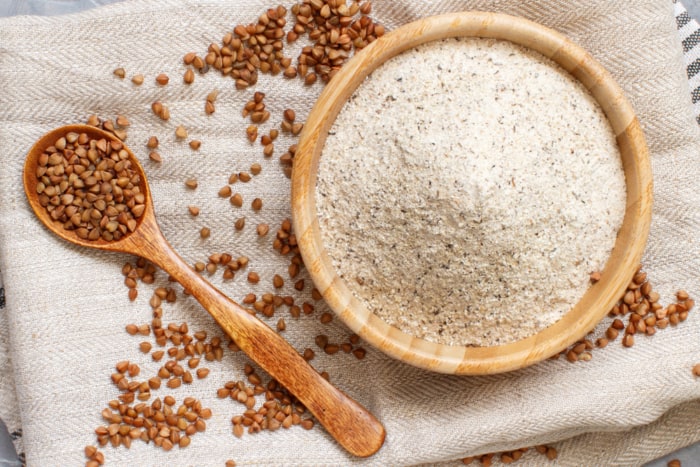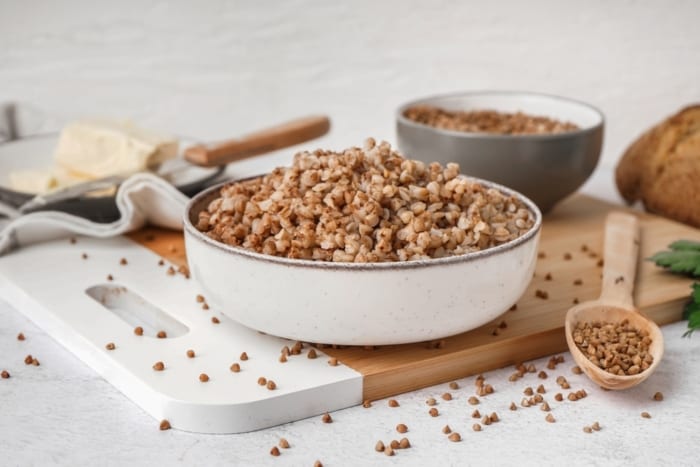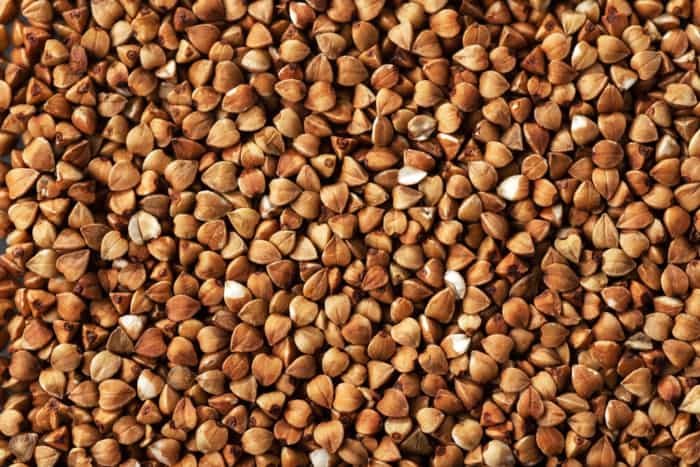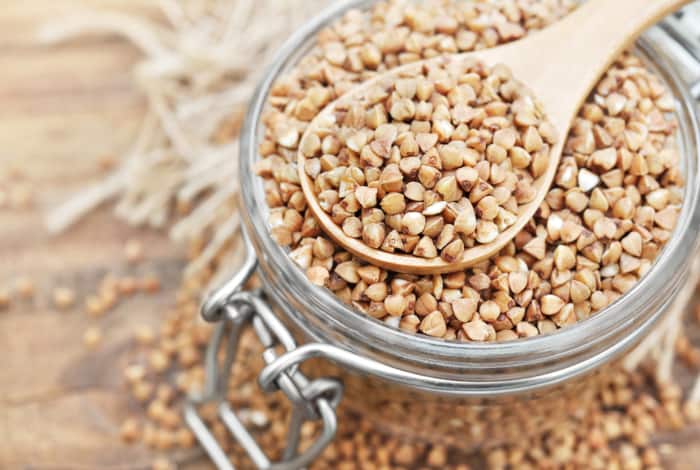Is Buckwheat Gluten Free?
In today’s health conscious world, the topic of gluten and gluten free diets is more popular than ever. Gluten intolerance and conditions like Celiac Disease have encouraged many people to analyze their diet. One grain (or rather, pseudo grain) that often gets confused in the gluten world is buckwheat. A common question is: “Is buckwheat gluten free?”

What is Buckwheat?
Contrary to its name, buckwheat is not related to wheat at all. In fact, it is not even a grain. Buckwheat is a pseudograin, which means it is a seed that is consumed like a grain. Foods such as quinoa and chia seeds also fall into this category. The name might be misleading, but the dietary complications are clear.
I have been gluten free for over 7 years and I have never had trouble digesting buckwheat. However, it is best to consult your doctor.
The Many Gluten Free Uses of Buckwheat
Buckwheat, a gluten free powerhouse, boasts a rich, earthy flavor and a versatility that can transform many dishes. Its gluten free status has made it an alternative for many, and its culinary potential reaches far beyond the common buckwheat pancake. Here are some interesting uses:
1. Breakfast Staples
Buckwheat Porridge: By simmering buckwheat groats in milk or water, you create a hearty, nutritious porridge. Top it with fresh fruits, nuts, or a dash of cinnamon for a filling morning meal.
Buckwheat Granola: Combine raw buckwheat groats with oats, nuts, seeds, honey, and dried fruits, then bake for a crunchy, healthy granola.
2. Wholesome Baked Goods
Buckwheat Muffins: Infuse your muffins with an earthy flavor by using buckwheat flour, perfect when paired with blueberries or chocolate chips.
Buckwheat Banana Bread: Enhance the richness of traditional banana bread by replacing or mixing regular flour with buckwheat flour.
Check out Is Baking Soda Gluten Free?
3. Satisfying Main Courses
Soba Noodles: These Japanese noodles, made mostly from buckwheat flour, are perfect in both hot broths or chilled salads.
Buckwheat Stuffed Peppers: Stuff bell peppers with a mix of cooked buckwheat groats, veggies, and your protein of choice for a well-rounded meal.
Buckwheat Risotto: Giving traditional risotto a twist, using buckwheat groats offers a unique texture and flavor to this classic dish.
4. Sides and Salads
Buckwheat Tabbouleh: A fresh take on the Middle Eastern classic, replace bulgur with buckwheat groats for a gluten free version.
Buckwheat and Veggie Salad: Toss cooled buckwheat groats with chopped veggies, olive oil, lemon juice, and herbs for a tasty salad.
5. Snacks and Light Bites
Buckwheat Crackers: Ideal for cheese boards or dips, these gluten free crackers can be seasoned as you like.
Buckwheat Popcorn: Puffed buckwheat can be enjoyed as a crunchy snack, similar to popcorn but with a different texture.
6. Drinks and Refreshments
Buckwheat Smoothie Bowl: Blend buckwheat with fruits, yogurt, and a touch of honey, then top with seeds and nuts for a wholesome smoothie bowl.
Buckwheat Tea (Soba Cha): Brewed from roasted buckwheat kernels, this caffeine-free tea is both aromatic and soothing.
What Is Gluten?
Gluten is a general name for the protein found in wheat, barley, and rye. It is also added to foods as a thickening agent or to provide texture and flavor. Gluten has a stretchy quality to it and is the ingredient that gives bread and baked goods their chewy texture.
Gluten is made up of two types of proteins: prolamins and glutelins. Prolamins are the protein that are responsible for gluten’s elasticity and chewy texture. Glutelins are the proteins that give gluten its strength and structure.
Gluten can be found in many different types of foods, including:
- Bread and baked goods, such as cakes, cookies, muffins, and pies
- Pasta and noodles
- Cereals
- Pizza dough
- Beer and malt beverages
- Processed meats, such as hot dogs and sausage
- Sauces and dressings
- Some types of candy
If you are following a gluten free diet, it is important to read food labels carefully. Many foods that you would not expect to contain gluten, such as processed meats and sauces, may actually contain it.
Should Everyone Avoid Gluten?
Gluten, a family of proteins found in grains like wheat, rye, and barley, has become a controversial topic in the realm of nutrition and wellness. While some argue for its exclusion due to potential health benefits, others believe that avoiding gluten is not necessary for everyone. Let’s delve deeper into this question: should everyone avoid gluten?
1. Who Should Definitely Avoid Gluten?
There are specific groups of individuals for whom gluten avoidance is essential:
Celiac Disease Sufferers: Celiac disease is an autoimmune disorder where the ingestion of gluten leads to damage in the small intestine. For these individuals, consuming even trace amounts of gluten can cause serious health complications.
Wheat Allergy Patients: Some people have a true allergy to wheat. While wheat allergy doesn’t necessarily mean an allergy to gluten (since wheat contains proteins other than gluten that can be allergenic), avoiding gluten-containing wheat products is a safe bet.
Non-Celiac Gluten Sensitivity (NCGS): This is a less well-defined condition where individuals do not have celiac disease but still experience symptoms when they consume gluten. Symptoms can range from digestive issues to fatigue or headaches.
2. Gluten Free as a Dietary Choice
Many individuals who do not fall into the above categories choose to go gluten free, believing it offers health benefits. Some reasons include:
Perceived Health Benefits: Some believe that a gluten free diet boosts energy, leads to weight loss, or reduces inflammation, though scientific evidence supporting these beliefs is limited.
Digestive Comfort: Some people find that reducing or eliminating gluten may help with bloating or irregular bowel habits, even if they don’t have a diagnosed gluten sensitivity.
Following Trends: With celebrities and influencers promoting gluten free lifestyles, some people adopt this way of eating based on its trendiness rather than health needs.
3. Potential Drawbacks of Avoiding Gluten Unnecessarily
Avoiding gluten when it’s not medically necessary can have downsides:
Nutritional Deficits: Whole grains that contain gluten, such as wheat, barley, and rye, are rich in essential nutrients like fiber, iron, calcium, and B vitamins. Avoiding them without a valid reason might lead to missing out on these nutrients.
Expense: Gluten free products often come with a higher price tag compared to their gluten-containing counterparts.
False Sense of Health: Just because a product is labeled “gluten free” doesn’t mean it’s healthier. Some gluten free products are high in sugar, fat, or calories.
4. Consultation is Key
If someone suspects they might have a reaction to gluten, it’s essential to consult with a healthcare professional. Self-diagnosing and starting a gluten free diet without medical advice might mask potential underlying conditions.

Buckwheat vs. Wheat
Both buckwheat and wheat are commonly used in various culinary applications around the world, but they differ significantly in terms of their botanical origins, nutritional content, and potential health implications. Here is a comprehensive comparison:
1. Botanical Classification:
Buckwheat: Despite its name, buckwheat is not a type of wheat or even a grain. It is a pseudocereal, which means it’s a seed from a flowering plant. Specifically, buckwheat is related to rhubarb and sorrel.
Wheat: Wheat is a true cereal grain derived from the grass family. Varieties include durum, hard red, soft red, hard white, and soft white.
2. Gluten Content:
Buckwheat: Buckwheat is naturally gluten free, making it a popular choice for those with celiac disease, gluten sensitivities, or those choosing to follow a gluten free diet.
Wheat: Wheat contains gluten, a protein composite that gives bread its elasticity. Gluten can be problematic for individuals with celiac disease, wheat allergies, or non-celiac gluten sensitivity.
3. Nutritional Profile:
Buckwheat: Buckwheat is rich in various minerals like magnesium, manganese, and copper. It’s also a good source of fiber, antioxidants, and high-quality protein containing all essential amino acids.
Wheat: Wheat is also nutritionally dense, providing B vitamins, iron, calcium, magnesium, phosphorus, and fiber. Whole wheat, in particular, is highly nutritious as it contains all parts of the grain.
4. Culinary Uses:
Buckwheat: Commonly ground into flour for pancakes, noodles (like Japanese soba noodles), and bread. Whole buckwheat groats are also used in dishes like porridge or salads.
Wheat: Wheat is a staple in many diets and is used to produce a vast array of products, including bread, pasta, pastries, cereals, and more.
5. Taste and Texture:
Buckwheat: Buckwheat has a distinct, earthy flavor and can be a bit stronger in taste compared to regular wheat. Its texture can vary from soft (when cooked as groats) to grainy (when used as flour).
Wheat: Wheat’s flavor is milder and is often described as nutty. Its texture varies widely based on preparation, ranging from the soft crumb of bread to the firm bite of pasta.
6. Potential Health Benefits:
Buckwheat: Studies have shown that buckwheat can help lower blood sugar levels, making it beneficial for diabetics. It’s also been associated with improved heart health and cholesterol levels.
Wheat: Whole wheat consumption is linked to reduced risk of heart disease, type 2 diabetes, and certain cancers. The fiber in whole wheat can also aid in digestion.
How to Use Buckwheat Flour
Buckwheat flour, with its robust, earthy flavor, is a versatile ingredient in the kitchen. Especially valued by those on gluten free diets, it brings a unique texture and taste to a range of dishes. Here’s how you can make the most of this gluten free flour:
1. Baked Goods:
Breads: While you can’t replace wheat flour entirely in a bread recipe due to gluten’s role in providing structure and elasticity, you can substitute a portion of it with buckwheat flour for a darker, richly flavored bread.
Pancakes and Crepes: Buckwheat flour is famous for pancakes, especially the classic French “galettes.” Mix with a bit of salt, water, and egg to create a batter, and then fry in a hot skillet.
Muffins and Cakes: Replace a portion of regular flour with buckwheat flour for added flavor. Remember that it can make baked goods denser, so adjust your recipe accordingly.
2. Pasta and Noodles:
Soba Noodles: These Japanese noodles are traditionally made from a combination of buckwheat flour and wheat flour. They’re served either chilled with a dipping sauce or in a hot broth.
Homemade Pasta: For a gluten free pasta option, you can mix buckwheat flour with other gluten free flours and binders to create noodles.
3. Thickening Agent:
Sauces and Gravies: Use buckwheat flour as a gluten free alternative to wheat flour for thickening sauces, gravies, and soups.
4. Breakfast Dishes:
Porridge: Though not a common use of the flour, you can cook buckwheat flour with water or milk to make a type of porridge. Add fruits, nuts, and sweeteners as desired.
5. Coatings and Batters:
Frying: Buckwheat flour can be used as a coating for fried foods or mixed into batters for a distinct taste and texture.
6. Binding:
Veggie Burgers or Meatballs: The flour can act as a binder in recipes like vegetable patties or meatballs, holding the ingredients together.
Tips for Using Buckwheat Flour:
Blending with Other Flours: Because buckwheat flour is gluten free, it doesn’t provide the same structure as wheat flour. For some recipes, especially baked goods, it’s beneficial to blend buckwheat flour with other flours to achieve the desired texture.
Adjusting Liquid Ratios: Buckwheat flour might absorb liquid differently than other flours, so you may need to adjust the liquid quantities in your recipe.
Storage: Buckwheat flour can go rancid if stored for too long. Keep it in a cool, dark place and consider refrigerating or freezing it to extend its shelf life.
Recipe Ideas To Replace Buckwheat
If you’re looking to replace buckwheat in recipes, here are some alternative ingredients and ideas to help maintain the texture and flavor profile of your dishes:
1. Breakfast Porridge:
Instead of Buckwheat Groats:
Quinoa Porridge: Use quinoa as a base and cook it with milk or water. Add your favorite toppings like fresh fruits, nuts, and a drizzle of honey or maple syrup.
Oats: A classic breakfast choice. Prepare steel-cut oats or rolled oats for a creamy, satisfying alternative.
2. Noodles:
Instead of Buckwheat-based Soba Noodles:
Rice Noodles: Easily available and quick to cook. Ideal for stir-fries, soups, or cold salads.
Whole Wheat Spaghetti: While it contains gluten, it can be a good substitute for soba in terms of texture.
3. Baking:
Instead of Buckwheat Flour:
Almond Flour: Great for gluten free baking, almond flour offers a nutty taste and is a common replacement for various flours.
Coconut Flour: Another gluten free alternative, coconut flour has a slight sweetness and can absorb more liquid than most other flours, so adjust recipes accordingly.
Oat Flour: You can make this by grinding rolled oats in a blender. It offers a mild flavor and works well in muffins, pancakes, and more.
4. Thickening Soups and Sauces:
Instead of Buckwheat Flour:
Cornstarch: A common thickener that’s gluten free. Mix with a little cold water before adding to your dish.
Arrowroot Powder: A natural thickener that’s neutral in flavor and gluten free.
5. Pancakes and Crepes:
Instead of Buckwheat Flour:
All-Purpose Flour or Whole Wheat Flour: If gluten isn’t an issue, these can be direct replacements.
A Blend of Gluten Free Flours: Combining rice flour, tapioca flour, and potato starch can mimic the consistency of many traditional flours.
6. Crusts and Breadcrumbs:
Instead of Buckwheat Flour or Groats:
Almond Meal: Works well for pie crusts or as a breadcrumb alternative.
Ground Flaxseed or Chia Seed: These can be combined with other flours to add a nutty flavor and extra nutrition to crusts.

What Are the Health Benefits of Buckwheat?
Buckwheat, a gluten free pseudo cereal, boasts a variety of health benefits that have made it a valued food source in many cultures for centuries. Here’s a rundown of some of the primary health benefits of buckwheat:
1. Rich in Nutrients and Antioxidants:
Vitamins and Minerals: Buckwheat contains numerous vitamins and minerals, including manganese, magnesium, phosphorus, niacin, zinc, iron, and folate.
Antioxidants: It’s also rich in antioxidants like rutin, quercetin, and other polyphenols, which help combat oxidative stress in the body.
2. Supports Heart Health:
Lowers Cholesterol: Some studies have shown that buckwheat can help lower LDL cholesterol and raise HDL cholesterol, potentially reducing the risk of heart disease.
Rutin: The flavonoid rutin, found in buckwheat, is known to strengthen blood vessels and improve circulation.
3. Improves Blood Sugar Control:
Resistant Starch: Buckwheat contains resistant starch, which acts similarly to soluble fiber and can help improve insulin sensitivity.
D-chiro-inositol: Buckwheat is a good source of this compound, which has been shown to lower blood sugar levels and help manage diabetes.
4. High Fiber Content:
Digestive Health: The fiber in buckwheat can aid digestion and promote a healthy gut. It helps prevent constipation and maintains regular bowel movements.
Satiety: Foods high in fiber, like buckwheat, can promote feelings of fullness, potentially aiding in weight management.
5. Gluten Free:
Safe for Celiac Disease and Gluten Sensitivity: Since buckwheat is naturally gluten free, it’s a suitable grain alternative for people with celiac disease or non-celiac gluten sensitivity.
6. Supports Weight Loss:
Protein: Buckwheat is relatively high in protein, which can help increase feelings of fullness and reduce appetite.
Low-Calorie Content: Buckwheat is lower in calories than many other grains, making it a favorable option for those watching their caloric intake.
7. May Have Anti-Inflammatory Properties:
Phytonutrients: The phytonutrients in buckwheat may help fight inflammation in the body, which is linked to numerous chronic diseases.
8. Skin Health:
Zinc and Niacin: Buckwheat contains both zinc and niacin, which are known to support skin health and improve complexion.
Tips for Gluten Free Cooking with Buckwheat
Cooking gluten free with buckwheat can be a rewarding experience. Buckwheat offers a unique, earthy flavor and a variety of health benefits. Here are some tips to help you make the most of this gluten free pseudo cereal in your kitchen:
1. Start with Whole Buckwheat Groats:
Whole buckwheat groats can be rinsed and cooked similarly to rice or quinoa. Once cooked, they have a soft, slightly chewy texture and can be used in salads, pilafs, or as a rice substitute.
2. Understand the Different Forms:
Buckwheat comes in various forms: whole groats, cracked groats (often labeled as kasha, which is roasted), and flour. Each has its specific culinary application, so choose the right form for your dish.
3. Mix Flours for Baking:
While buckwheat flour can be used on its own, many gluten free recipes benefit from a mixture of flours to achieve the best texture. Combine buckwheat flour with other gluten free flours like almond flour, rice flour, or tapioca starch.
4. Hydration Matters:
Buckwheat flour tends to absorb more moisture than some other flours. When baking, you might need to add a bit more liquid to your dough or batter to achieve the right consistency.
5. Avoid Cross-Contamination:
If you’= are cooking gluten free due to celiac disease or sensitivity, ensure that your buckwheat products haven’t been processed in a facility that also processes wheat or other gluten-containing grains.
6. Experiment with Traditional Dishes:
Buckwheat is a primary ingredient in several traditional dishes like Russian blinis or French galettes. Explore these recipes to familiarize yourself with the flour’s properties.
7. Toast for Enhanced Flavor:
Toasting buckwheat groats (especially if they aren’t already roasted) before cooking can enhance their flavor.
8. Use as a Binding Agent:
Buckwheat flour can be used to bind ingredients together in recipes such as veggie burgers or meatballs.
9. Pay Attention to Cooking Times:
Buckwheat groats can become mushy if overcooked. It’s best to check them a few minutes before the suggested cooking time is up to ensure the desired texture.
10. Storage is Key:
Store buckwheat flour in a cool, dry place. If you live in a particularly warm climate or don’t plan to use it quickly, consider refrigerating or even freezing the flour to maintain its freshness.

Frequently Asked Questions (FAQs)
Yes, buckwheat is a healthy food. It is a good source of protein, fiber, minerals, and antioxidants. Buckwheat is also naturally gluten free, making it a good choice for people with celiac disease or gluten sensitivity.
Grains like rice, quinoa, millet, amaranth, buckwheat, corn, and sorghum are gluten free. Always check for cross-contamination in processed products.
Yes, cooked buckwheat is gluten free. Buckwheat is a naturally gluten free pseudocereal, which is the seed of a flowering plant. It is not closely related to wheat or other gluten-containing grains.
Quinoa, rice, millet, buckwheat, amaranth, and sorghum are six gluten free grains.
You May Also Like
- Are Reese’s Gluten Free?
- Gluten Free Tortillas
- Gluten Free Cupcakes
- Are Sprinkles Gluten Free?
- Gluten Free Bread Recipe
- Is Peanut Butter Gluten Free?
If you found this post helpful, I would really appreciate a review! You can find me on Instagram, Facebook, and Pinterest. Join my exclusive Facebook Group for a behind the scenes look. I would love for you to follow along! For more ideas, check out these Dessert Recipes.

